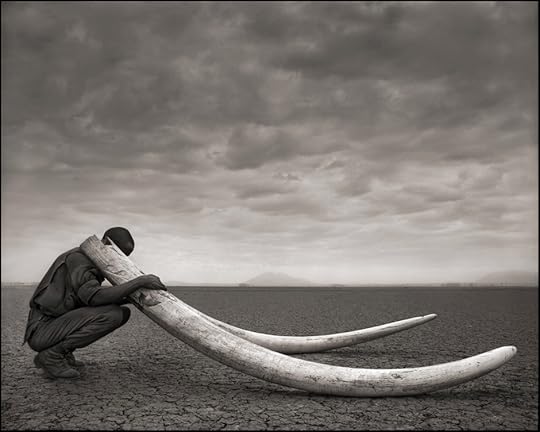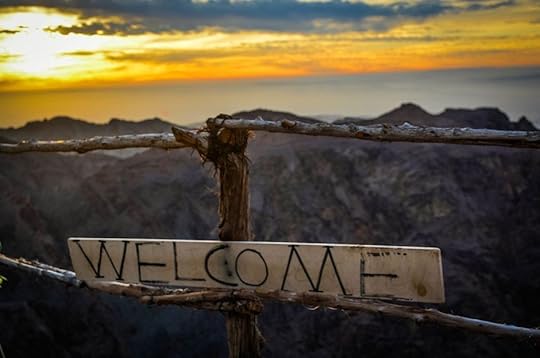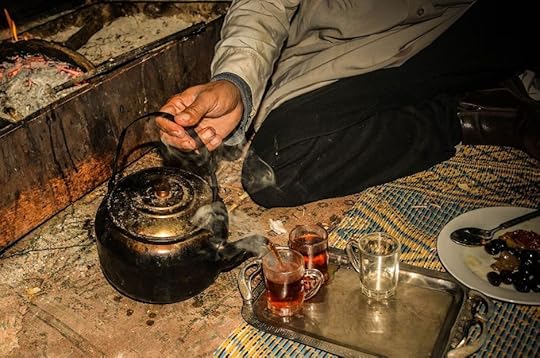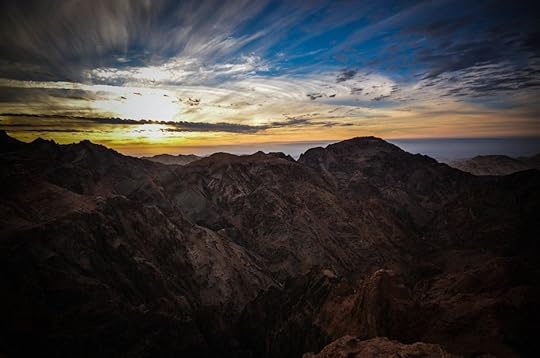Matador Network's Blog, page 2180
November 23, 2014
Why traveling with kids is better
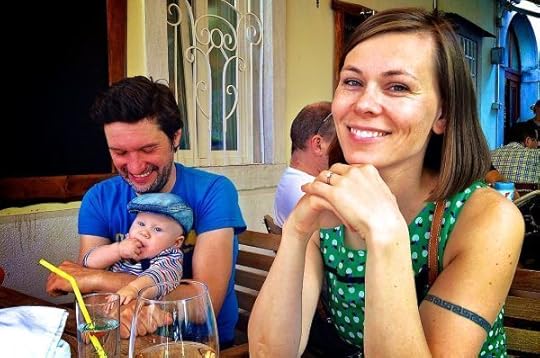
Photo: Siim Teller
A lot of people seem to think that you can’t travel with your kids. Believe me, they are missing out. It’s not as easy as tripping around by yourself, but ease isn’t the reason you got into parenthood anyways. Having the kids along can enhance the trip in many ways.
1. It’s safer.
I’ve had people look at me like I’m crazy for traveling with my kids, especially when they were babies. “Isn’t it dangerous?” is what I heard most. The crazy thing is that having your kids with you — the younger the better — can be a real safety feature.
My eldest son was born while we were traveling on a sailboat in Mexico. ‘Pirates’ were a concern, especially for lone boats hanging out at the lovely deserted islands in the Sea of Cortez. So I was dubiously heartened to hear a popular story going around at the time; Pirates boarded a family’s boat while the husband was away. When they saw a mother and baby alone inside, they turned around and left.
I know from experience that everyone from corrupt police officers to opportunist mechanics become downright friendly and helpful when my toddler smiles at them. Most people in this world really don’t want to take candy from a baby.
2. Kids make you less of a tourist.
People that would have, at best, seen you as a rip-off opportunity (and, at worst, a crime target) suddenly see you as a normal, perhaps more interesting person — “Can I hold the baby?” Kids are kids, regardless of race, religion, or economic status, and it’s hard to resist them.
In turn your kids will relate to their new surroundings similarly, without prejudice, if you let them. Watching your kids having a ball playing soccer with the local kids in Little Native Village, Mexico, might remind you of just how similar we all are at heart.
3. Kids are a natural icebreaker.
You’ll be chatting with them all the time, which broadcasts your native language and a little bit about you, making it simple for other travelers or locals to strike up a conversation. People are naturally curious and would often love to get to know you, but feel intimidated. That shy Ecuadorian just dying to try out her high school English will find it much easier to get the courage to say something to your 5-year old. Nothing is less intimidating than a family.
By the same token, the kids may encourage you to overcome your own reluctance, especially with language…at least your pronunciation of “Where is the bathroom?” is pretty well guaranteed to achieve native level.
4. Kids will take you places you wouldn’t have gone on your own.
Kids give you a reason to be just about anywhere (except nightclubs). You’ll find yourself playing in local parks, checking out the hotel facilities, and stopping at yet another ice cream shop. You’ll still do all of the usual stuff — maybe more, since you don’t want them to miss anything. But you’ll pay more attention to the museum explanations, get to do all the activities, and always have a plausible reason/excuse to do whatever you really want to do (ex: “But little Johnny has to tell his friends he climbed the Eiffel Tower!” or “You expect little Johnny to climb the Eiffel Tower?!”)
5. They’ll make you try any kind of food.
When kids aren’t busy playing control games with their parents, they love new and different kinds of food. Foreign bakeries are enticing, and the kids give you an excuse to try everything there is to offer. Food is such a huge part of any cultural experience and the number-one sensual pleasure of your pre-pubescent offspring — it’s going to be one of the most memorable aspects of any trip. The kids also make it so much easier to fully enjoy the local cuisine without gaining unwanted kilos — each one orders a different meal/dessert, and you get to ‘taste’ them all.
6. It’s a great challenge for everyone.
Traveling will challenge you, often in unexpected ways. We tend to want to shelter our children from hardship, even when we recognize that it is possibly the source of the best education. I would never in a million years have chosen to have the mast of our sailboat come down in a storm in the middle of the Gulf Stream. But it did, and it took all five of us to save the situation. No one enjoyed it at the time, but it became a favourite story and I think that we all realize how valuable that experience was.
Life isn’t all ‘smooth sailing,’ and who would want it to be? It’s so easy to let fear stop us from doing things — but the saying rings true: “It’s the things that you DIDN’T do that you will regret the most.” 

November 22, 2014
Snowboarders kill nipple deep pow
Do you feel it? You know, the unmistakable feeling in the air that massive powder days are near? Winter’s arrived and the snow is falling in places like Colorado, Tahoe, the Tetons, and, of course, Stevens Pass, Washington where this sick episode of “Nipple Deep” was shot.
Like any good ski flick, there’s a moral hidden in this tale of powder-chasing:
When it comes to snowboarding, there’s only one thing better than travelling to a place with tons of fresh powder waiting — having the locals show you the goods when you get there.
See? We learned something today — locally sourced pow is the best pow.
While all the news has been about the epic snowfall in Buffalo, New York, out West mountains are finally putting on their white winter dresses. It’s time. It’s here. Let’s get deep, nipple deep. 

The mass murder of African elephants
Take a look at the elephant in the photo below. His name is Igor (as named at birth by Cynthia Moss of Amboseli Elephant Research). For 49 years, he wandered the plains and woodlands of the Amboseli ecosystem in East Africa. A gentle soul like most elephants, he was so relaxed that in 2007, he allowed me to come within a few feet of him to take his portrait.
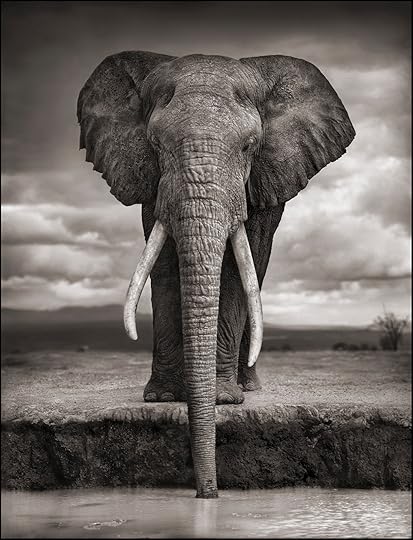
Elephant Drinking, Amboseli 2007. Killed by Poachers, 2009. All photos: Author
Two years later, in October 2009, it was perhaps this level of trust that allowed poachers to get close enough to kill him and hack the tusks from his face.
This book, Across the Ravaged Land, is the final book in the trilogy that I began in late 2000. Being something of a natural pessimist (always tempting to actually just say “realist”), I always felt that I was potentially making a final testament, an elegy, to the extraordinary natural world of East Africa, and the wild creatures that inhabited it. Back then, in my first book, On This Earth, I photographed what I saw as something of a paradise, an Eden. And it was, compared to what is happening today in 2013. But even 13 years ago, my pessimistic mind did not conceive that things would turn this bad, this quickly.
As I write, there is a continent-wide apocalypse of all animal life now occurring across Africa. When you fly over such a vast continent with so much wilderness, it’s hard to imagine that there’s not enough room for both animal and man. But between an insatiable demand for animal parts and natural resources from other countries, and a sky-rocketing human population, the animals are being relentlessly squeezed out and hunted down. There is no park or reserve big enough for the animals to live out their lives safely.
The statistics are finally, belatedly, starting to become known, and they need repeating:
Every year, an estimated 30-35,000 elephants are slaughtered across Africa. That’s 10% of the elephant population every year.
Fed by the massively increased demand from China and the Far East, ivory prices have soared from $200 a pound in 2004 to more than $2,000 a pound in 2013. China’s population is 1.3 billion and counting, and with 80% of its fast-growing middle class keen to buy ivory in some form, its price will only keep spiraling upwards. (It barely merits stating the obvious: Ivory is never more beautiful than when thrusting magnificently out of the face of an elephant).
As for rhino horn, it’s now more expensive than gold dust in the Far East, as the last rhino are gunned down to provide phony “medicine” for men with failed libidos.
There are an estimated 20,000 lions left in Africa today, a 75% drop in only 20 years. Most of this decline is due to conflict with the fast-growing human population. But increasingly, lions are killed for body parts like claws, bones, and teeth, again for the Asian market, now that tigers are too hard to procure. It has become so bad that there are next to no lions left outside the parks and reserves.
Viewing the steep downward slope on the graphs, it means this: At the current rate of slaughter, there will be no elephants, no lions, no cheetahs left in the vast expanse of the African continent within 15 years.
The only place you will be able to see them is in the sad, drab confines of zoos. Or in fenced areas that constitute barely more than a glorified zoo. Once again, man is on the path to systematically exterminating entire species of his fellow creatures in the natural world. Will humanity learn and change as a result? Based on history, the despairing answer is no.
It all sounds fairly bleak, and much of the future inevitably will be. But there is a “however…” There has to be a “however…”
But we have to be prepared and willing to engage in the most almighty fight for it….
* * *In July 2010, I returned for the first time in two years to the Amboseli ecosystem, a two million-acre area bordering Kenya and Tanzania in the shadow of Mount Kilimanjaro. Over the previous six years, I had spent many months photographing the elephants that inhabit this region. As a result, I had been fortunate to come to know some of these amazing creatures intimately.
Whilst there in 2010, I learned about the killing the year before not only of Igor, but others as well, like Marianna, the matriarch purposefully leading her herd in the photograph below.
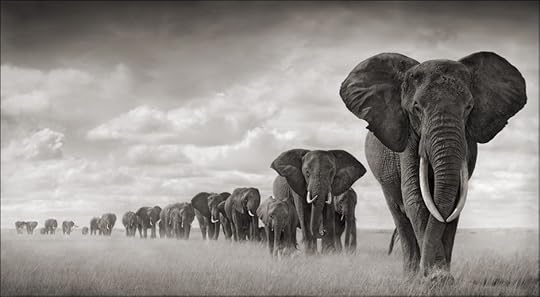
Elephants Walking Through Grass, Amboseli 2008. Leading Matriarch Killed By Poachers, 2009
Day after day, we tried to approach what had once been some of the most relaxed of elephant herds, elephants that in the past had quietly made their daily journey to the swamps, moving past and around our vehicle without a care in the world. But this time, when we approached to within half a mile, they would run in terrified panic. Meanwhile, gunshots were being reported from the direction that the elephants came, near the Tanzanian border.
We tried reporting what we’d seen, but nothing was done, nothing happened. The Kenya Wildlife Service was (and still is) underfunded, and the few NGOs in the area had insufficient funds and infrastructure to make much of a difference. On the Tanzanian side, there was no one at all engaged in protection or conservation. And this was here in the Amboseli ecosystem, one of the most important and famous in Africa, with the most spectacular remaining population of elephants to be seen in East Africa.
Over the coming weeks, there was a lot of bad news. Just six weeks after I took the photo below of Winston, this 30-year-old elephant, barely into his prime, with half his life ahead of him, was shot by poachers over the border in Tanzania. Wounded, he made it back over to Kenya, where he died. He also had his tusks sawn out of his face with a power saw by the poachers. (And you won’t want to read this, but many are the elephants who are still alive when the chainsaw, or ax, starts hacking the ivory out of their faces).
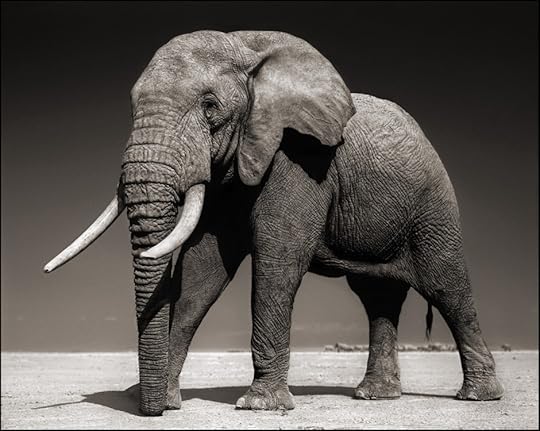
Elephant with Half-Ear, Amboseli, July 2010. Killed by Poachers, August 2010
Over the next couple of months, the roll call of big bull elephants killed by poachers came thick and fast: Goliath, Sheik Zahad, Keyhole, Magna, and more. It wasn’t just a case of if a big-tusked elephant was going to get killed, but when.
At first I thought the poachers would just target the elephants with big tusks. But elephants with tusks barely more than broken stumps were being killed by poachers. Which meant that really, no elephant was safe anymore.
The killing was also escalating for all the wild animals of the area. The plains animals were getting slaughtered; giraffes here in the region were being killed at a faster rate for bush meat; there were even contracts out on zebras, as their skins became the latest fad in Asia.
As I saw the destruction unfolding with almost no real or meaningful protection, I thought that I couldn’t just stay frustrated, depressed, and powerless. It’s no good being angry and passive. It’s much better to be angry and active.
And so, to my own complete surprise, I co-founded Big Life Foundation in late 2010, made possible by an incredibly generous donation from one of the best collectors of my photographs. Partnering with the highly regarded conservationist Richard Bonham, we set our sights on the Amboseli ecosystem as our pilot project: a nearly two million-acre area stretching across the Kenya/Tanzania border.
A little over two years later, Big Life has 280 rangers, 24 ranger outposts, 15 patrol vehicles, 2 planes for aerial monitoring, 3 tracker dogs, and a vast informer network across the whole region. It’s the only organization in East Africa with coordinated cross-border anti-poaching operations.
With this infrastructure in place, as of April 2013, the Big Life teams have achieved a dramatic reduction in poaching of all animals in the region. None of this could have happened without one critical element: With animals constantly moving far beyond park boundaries into unprotected areas ever more populated by humans, the only future for conservation of animals in the wild is working closely with local communities. Effective conservation is dead in the water without community collaboration. This is at the heart of Big Life’s philosophy. The people support conservation, conservation supports them.
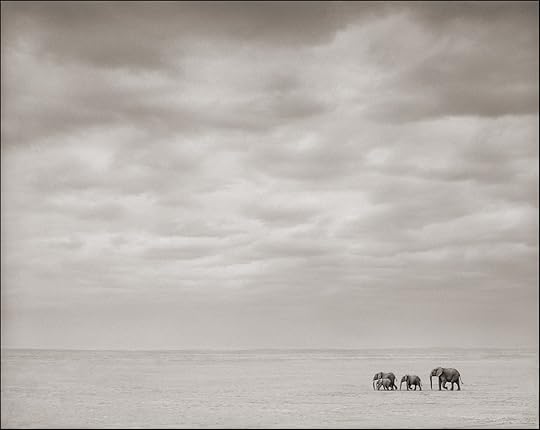
Elephants Alone on Lake Bed
In parts of the world such as this, very poor but rich in natural wonders, ecotourism is the only truly significant source of long-term economic benefit. Take away the animals, and there’s almost nothing of economic value left. The land can only support so much herding, and even less farming. And those meager resources will only become more unsustainable and precarious over time, as climate change kicks in and brutal droughts occur more frequently.
When you’re trying to protect close to two million acres, with the best will in the world, 280 rangers and 15 vehicles are only going to get you so far. That’s where the support of the community is essential.
Big Life’s expansive network of community informers is one of the main reasons why the rangers now apprehend poachers most times that they kill. Every one of those rangers lives locally, and with families whose well-being is tied to their success, and the wealth of the region increasingly understood by local people to be tied to the health of the ecosystem, so each ranger has his own small network of eyes and ears. Given the size of the area, I find it quite amazing, and very encouraging, just how often information does come through to the teams about poachers operating in the area. And on the poacher grapevine, it is now known that you run a big risk of being arrested if you attempt to kill in the Big Life-protected areas.
But the aim of Big Life has always been to do much more than just catch poachers. Its aim is to protect the entire ecosystem, both in the short and long term. Loss of wildlife habitat, the expansion of human settlement due to population pressure, and the resultant animals killed during raids on farmers’ crops or in retaliation for attacks on livestock — all add to the toll of lost wildlife. And all, in one way or another, we attempt to address.
Meanwhile, however, the destruction of wildlife continues, escalating and out of control, in the areas beyond where the Big Life teams operate. This is why this year, 2013, we began to extend operations into the Tarangire/Manyara area of Northern Tanzania, where large numbers of animals, from giraffes to zebras, were being gunned down for the bush meat markets of Arusha and beyond.
However, I don’t want this to turn into an extended pitch for what Big Life Foundation is doing. If you’re interested, you can discover more at Big Life’s website. But if you’ve made it this far, perhaps that means you might join the fray.
Unfortunately, we’ve reached a point where a series of terrible choices have to be made: what we can still try and save, and what we have no choice but to painfully, reluctantly sacrifice.
All across the African continent, there are entire populations of elephants and other animals now being wiped out. The list is long: animal populations in Chad, Central African Republic, Mozambique, Congo, large parts of Tanzania, and on and on. Tragically for many of the ecosystems in these places, any conservation group would face an overwhelming struggle to be effective — for lack of government support or community collaboration, for lack of money, for lack of firepower against the rebel militia groups that sweep in to murder en masse, financing weapons purchases with their bloody bounties of ivory. In fact, as I’m writing this, I’ve just read a news report about 86 elephants killed in the last week in Chad, including 33 pregnant females. And no one there to stop it for all these exact reasons.
So until sufficient national and international pressure is exerted to implement truly meaningful bans on the worldwide trade in animal parts, we will have to continue to choose which battles we stand a chance of winning, and those we know we cannot.
* * *
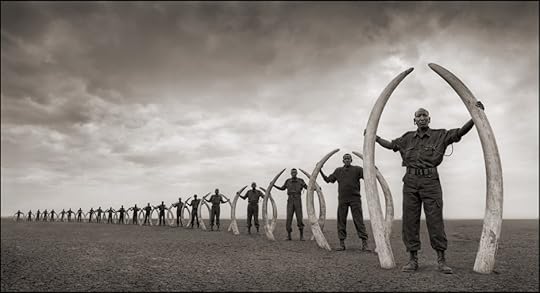
Big Life Rangers Holding Tusks of Elephants Killed at the Hands of Man, Amboseli 2011.
The photograph above shows 22 of the Big Life rangers holding tusks of elephants killed by men within the Amboseli/Tsavo Ecosystem in the years 2004-2009. The photo was taken to echo the earlier photograph, Elephants Walking Through Grass, reproduced further above.
Corporal Kitanki — at the front, and with one of the best track records of capturing poachers — is holding tusks that each weigh in excess of 120 pounds. These same tusks are supported on the shoulders of another Big Life ranger, Corporal Pepete, in the photograph on the cover of the book Across the Ravaged Land.
Those two gargantuan tusks, that bounty, would fetch close to half a million dollars in China today. However, as I look at those tusks in the photo today, I’m not thinking of that.
I’m looking at them thinking that actually, I find it hard to visualize the living elephant that possessed them. I’ve never seen elephants with tusks anything like that size, and now, I never will. They are all gone, dead, mostly killed by man. Even with one part of each tusk embedded in his skull, this elephant would still surely have had to lift his monumental head to prevent them from dragging like excavators through the earth.
* * *
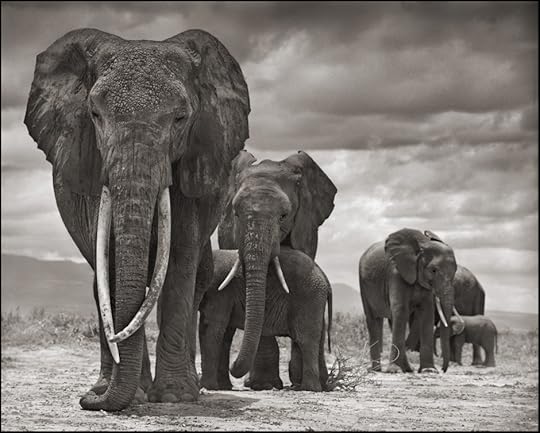
Qumquat & Family, Amboseli, October 27 2012
On October 27 2012, I took the photo above, of Qumquat, one of Amboseli’s most famous matriarchs, and her family. Beyond are two of her daughters, Qantina and Quaye, bearing smaller tusks. You can see that I was just a few feet from the family, so trusting, so relaxed. Such easy pickings for poachers with a mind to murder for profit. Sure enough, this was to be their last afternoon alive.
Twenty-four hours after this photograph was taken, Qumquat, Qantina, and Quaye were gunned down by one of Amboseli’s most notorious poachers (whom the Big Life rangers subsequently apprehended). As for the three youngest, two are missing, the younger almost certainly dead now. Only the youngest calf is alive, his new home the David Sheldrick Wildlife Trust Orphanage in Nairobi. This is the kind of collateral damage that the poachers cause: abandoned, traumatized calves that cannot survive once their mothers are gone.
Qumquat was a wonderful matriarch, who successfully led her herd for many years. But in one hellish afternoon, three generations of her family were exterminated.
Meanwhile, there are thousands of other Qumquats and sons and daughters still across much of Africa, many of whom will inevitably meet a similar fate. Whether this kind of senseless destruction motivates you to donate to Big Life, or another group working to protect the animals or environment here or elsewhere on the planet, it doesn’t matter. What matters is that, cliched as it sounds, if you care, get involved. Don’t be angry and passive. Be angry and active.
This book marks the end of a trilogy — On This Earth, A Shadow Falls, Across the Ravaged Land — that began in paradise, and ends in a much more somber place. I took portraits of the animals in these books in an attempt to capture them as sentient creatures not so different from us. I have sought to photograph them not in action, but simply in a state of being. Let us continue to let them be. ![]()
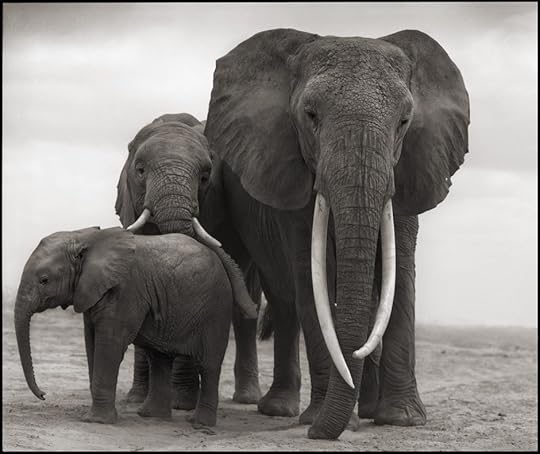
Qumquat with Daughters, Amboseli, 2012
This post was originally published at NickBrandt.com and is reprinted here with permission. It was originally posted on Matador on October 30, 2013.

8 things the Greenlandic hate
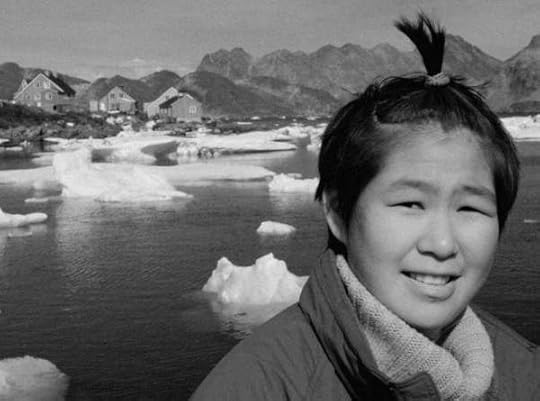
Photo: Nick Russill
1. Losing our jobs to the Danish
Since 1814, when Danish people colonized in Nuuk, they have been moving up here. The Danish actually make up approximately one quarter of the capital’s population. And that’s a big number. Let’s face it, Danish people have much more opportunity for professional experience back in Denmark. So when they come here, they qualify for better jobs than us. Sometimes we Greenlandic are even expected to speak Danish in our own country. But we’ve been living here longer than them — we deserve those jobs!
2. Not being able to buy alcohol whenever we want
Monday through Friday, you can’t buy alcohol after 6pm. On Saturday, you can only buy until 1pm. There is not one minute that you can buy alcohol on a Sunday. It’s ridiculous. We’re forced to buy alcohol on Friday afternoon, before we’ve even decided if we’re going to party or not.
And the prices! A case of 30 bottles in Denmark costs 100 DKK. In Greenland, 20 bottles cost about 200 DKK. They really make it difficult for us to drink. There are some communities that have problems with alcohol abuse, some have made it a law that you can’t buy any over 15% potency. So maybe the restrictions are a good thing in some places. But, no, we still hate it.
3. Delays and more delays that happen almost every day
We have very few transportation options when we want to visit other cities in Greenland. It’s usually either plane or ship. We have no roads between cities because and our cities are scattered everywhere with many miles in between. For instance, the capital Nuuk’s closest neighbor city, Maniitsoq, is 148-kilometers away.
Greenland is not a place of sunny and hot days. We have very unpredictable weather that can change a sunny day into a rain or snowstorm. And even if the city you’re in has sun, there’s a big chance that the one you want to get to has a storm. So always buy a green ticket.
4. The complete lack of products in our stores
Greenland’s environment can’t support fruit-and-vegetable trees, so all of our produce comes from Denmark. And it’s not uncommon for a store to just run out of something and be unable to get it back for awhile. You know that feeling when you think all day about a dish you want to make for dinner? You crave it so much that it doesn’t matter how expensive it will be to make. And the store just runs out of the crucial ingredient. In some Greenlandic cities, it can take up to three months for something to come back into stock. And the fewer the products are, the more expensive they get.
5. When it rains in winter
The rain falls differently here in Greenland than any other country. In Denmark or the States, big drops of rain fall vertically to the ground. It’s not that easy here. In Greenland, the raindrops are small and fall from right to left, making the air humid and melting all the snow. And what do you get the day after? Icy roads and people doing ninja moves everywhere.
6. When large insects just show up all of a sudden
Just….ew. Greenland is located in the arctic where trees can’t even grow because of our hard and frozen ground. It’s definitely not a place for insects to thrive. We don’t see many except for mosquitoes, flies and the occasional spider — no bigger than your fingernail. But sometimes in summer, something like a cockroach will appear and gross us out. They probably come over on ships or planes from other countries. Oh man, you will never see an uglier face than the one a Greenlandic makes when she sees a huge insect. She may scream.
7. Anything that’s run by the government
Where do I even begin with this? The doctor’s office is a real bitch to get a hold of, and when you finally do get them, there’s only a slight chance that they’ll give you their support and concern. The dental office opens early in the morning. If you want to get checked, you have to get in a line that started an hour before the doors even open. The student salary is way too low and the dorms have mold and other disgusting things growing in them. We know that we should be thankful because all of this stuff is free — doctor visits, dental visits, education — but we love to complain about it.
8. How short our summers are
Even though we love snow — the skiing, the making snowmen, the getting cozy with hot chocolate — we really enjoy our three-month summer. But three months? Sometimes it’s even less. We always remember the first summer day, when we can finally wear short trousers and just a t-shirt outside. We go hiking, boating, and fishing. Many of us travel to another city or even another country for summer break. But when we get back, it’s all rain and cold breezes. And it’s only August. 

November 21, 2014
Things Pacific NW peeps hear a lot
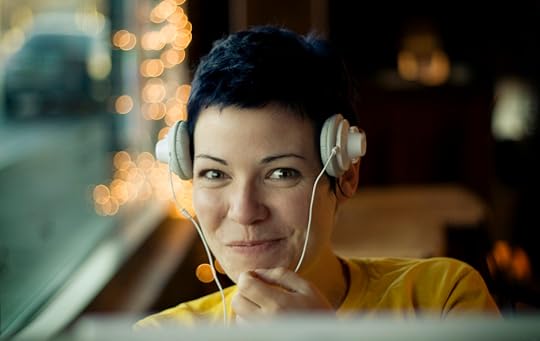
Photo: Kevin O’Mara
1. “For living so close to the mountains, you guys sure can’t handle the snow.”
No shit, Sherlock — we’re too busy hiding from the perpetually enraged rainclouds and their relentless onslaught of rain. You expect us to be ready for frozen snow amid all that?
We get this line most often from the overly-opinionated East Coast transplant who’s dumbfounded we can’t handle a half foot of snow because he grew up forging ice tunnels out of his home. Sorry man, we’re out here trying to deal with minefields of puddles most of the time.
2. “I bet you carry an umbrella with you everywhere you go.”
Actually, no. If you’ve lived in the PNW long enough you’ve come to terms with the cold, hard truth: an overpriced rain jacket that doesn’t soak through every time it’s out in the rain is better than poking every passerby pedestrian’s eyes out when trying to use an umbrella. Every time I use an umbrella I feel as I’ve been given a weapon that acts on its own accord. Where’s the umbrella instruction manual?
3. How’s the population of Forks, Washington handling the moody teenage vampire crisis?
Yes, Stephenie Meyer’s Twilight series is staged around Forks, Washington. But Forks is a bland, old-fashioned, underdeveloped backwoods where the weather’s just as shitty as most anywhere else in Washington — except when you’re in Forks, you’re in the middle of nowhere, and the best thing about the town is a rundown pie diner you can visit if you want to feel like you’ve walked onto the set of True Detective.
So, really, there’s two reasons not to go to Forks: It’s a sleepy timber-logging town with irritable lumberjacks keen on taking hatchets to Edward Cullen cutouts (because, who wouldn’t be?), and it’s so painfully boring that Meyer recognized her readers wouldn’t make it past the first chapter of her book if there weren’t teenage werewolves with overdeveloped six packs and teen vamps with overapplied hair gel waging war over a girl who’s moping around because she’s stuck in Forks.
4. “You guys have great coffee!”
Tread carefully. We’ll likely judge which establishment you bring up. There are only two types of people in our books: you’re either a corporation-fueling dimbo to whom coffee’s no more than a daily necessity; or you’re an enlightened java bean connoisseur that appreciates presentation, atmosphere, and well-fostered relationships between barista and consumer found within fair trade, independent coffee shops.
5. “How about those Seahawks?”
There’s no such thing as an awkward silence when you can steer conversation back towards your world championship team.
6. “You’re so lucky you can see shows at The Gorge.”
Yeah, and you’re so lucky you can see concerts outside more than a few months out of the year. It’s as if the weather gods up above huddled together and decided they’d throw us a secluded spot with majestic, sun-soaked scenery to compensate for the lack of reasonable weather we normally live with.
7. “Why go through the trouble of spending a day at the beach when the water’s colder than a therapeutic ice bath?”
Just ‘cause our water isn’t toasty and aquamarine doesn’t mean we’re not going to pretend to enjoy it every once in a while. We’ll plan weekend getaways to Cannon Beach and take pictures with friends surrounded by sand dunes just as an excuse to avoid another hike up some shrub-infested trail. 

Why travel Muslim countries?
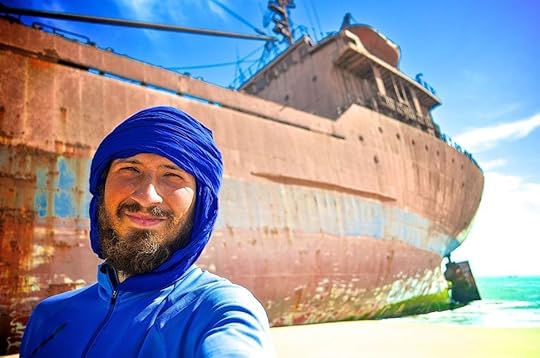
Photo: jbdodane
No part of the world within the last ten years has been scrutinized as much or stereotyped as heavily as the Muslim world. Although a minority of these countries have warranted the criticism, the media has unjustly painted the remaining majority as being similarly run, hateful of the west, and as places to be avoided.
Not only are these countries worth visiting, but what they offer is so unique that to be left off the list of any traveler would be a shame. When a friend asked me where would I recommend visiting the most, I answered Jordan — a 90% majority Muslim country.
“Isn’t it dangerous?” she asked.
My reply: “I feel safer in Amman than I often do in London.”
Ignore the media hype.
In the past 13 years, ‘Muslim’ and ‘terrorist’ have become synonymous in many countries in the western world. News organizations and Hollywood films do very little to distinguish between the minority and the majority, and sometimes even openly merge the two.
This mindset is extremely damaging to the world’s Muslim communities, degrading the vast majority due to the actions of a few, and perpetuating the myth that all Muslim countries are radicalized, are a danger to travelers, and are full of close-minded and stubborn people who hate Westerners.
In truth, there is as much variation in opinions in these countries as there is in our own, and plenty of Muslims are refreshingly open-minded. I even felt comfortable asking a guide in Jordan if I could scatter some of my dad’s ashes, knowing well that it was not accepted in Islam. Not only did he accept the idea, but he drove me to the spot he described as the “most beautiful and appropriate in the whole of the Wadi Rum desert.”

The “most beautiful and appropriate” spot in the Wadi Rum desert. This and all subsequent photos courtesy of the author.
The hospitality of Muslim cultures is truly life changing.
One of my favorite memories is of sitting on a mountaintop with a Bedouin, gazing upon a surreal sunset and hearing him say, with absolute sincerity, that you could offer him the best car and the biggest house in the world, but he would not change his life for any of that.
“It is enough,” he said, “to meet people who come visit my country, converse with them, learn from them, but then to come up here every evening and gaze upon this sight.” Propped up next to him, appropriately surveying the same sun setting down behind a canyon of mountains was a slab of wood with ‘WELCOME’ written in black paint across it.
The welcome sign was not an anomaly: Islamic and Arabic society puts a tremendous emphasis on the tradition of hospitality. This will become clear once you have been offered your tenth different invitation for dinner or tea in two days. For travelers interested in discovering different cultures first-hand, such an experience is essential.
We can learn from Islamic culture.
On my first trip to Jordan, one of my taxi drivers stopped the car within seconds of my confession of having never tried falafel, popped into the ‘best falafel shop in the area’ and brought me one for free. He then watched as I ate it, excited to be sharing my cultural initiation into the Jordanian world. This attitude is not uncommon in Jordan.
Do we have this in our own society, where foreigners from all different walks of life are welcomed with such generosity and compassion? I myself find it difficult to imagine the reverse happening back home. I certainly have never received the same level of warmth as I felt while accepting Muslim family invitations while in a strange place in the western world. And despite being a white European and quite obviously not a local, I have felt no judgement in the Muslim world — only curiosity and respect.
In a world which is still so hostile towards people from different creeds, races and nationalities, maybe we could learn a great deal from a culture which strongly emphasizes the need to welcome strangers into their homes, acknowledge but not judge them by their differences, and offer them food, friendliness, and the opportunity to learn about one another.
No traveller should miss out on what the Muslim world has to offer.
Even setting the people and culture aside, we often forget that the Muslim world is full of dramatic and surreal landscapes, most of which are still relatively new to the western photographer’s checklist. The Musandam Fjords in Oman, Wadi Rum in Jordan, and Mount Damavand in Iran are three world-class destinations for photographers, filmmakers, and travellers searching for remarkable nature. Don’t let the misconceptions deter you — these are places every traveler simply cannot afford to miss.
The tea will always be offered: it will never run out and you will find it impossible to decline. It is sweet and warm, just like the company. 

8 memories of growing up in Philly

Photo: T_Rose
1. Hoagies and Huggies for lunch
For a kid growing up in the Northeast, a perfectly great lunch was an Italian hoagie with Utz chips on the side, accompanied by a lime-green Huggie to drink and a butterscotch krimpet (or other favorite Tastykake or Kandy Kake) for dessert. Cheese or tuna hoagies were great alternatives on Fridays during Lent, and Greenman’s Deli made the most epic hoagies of all.
2. Facing down the supernatural as a rite of passage
Childhood and adolescent tests of bravery often had the special twist of facing down the supernatural. I was initiated by conjuring Bloody Mary alone in a powder room, in the dead of night, in a haunted house, and to this day can’t look into a mirror in the dark. The pounding of sneakers and panicked gasps of breath echoing through the sprawling maze of tunnels under the abandoned Byberry Psychiatric Hospital still haunt my dreams. My stomach drops thinking about our idling car being drawn up Gravity Hill. And I remember, in my bones, the chill in the air that choked me in the vaulted corridors of Eastern State Penitentiary, and the clammy hand that gripped the back of my neck alone in a cell, that said though I could run, I could never forget the truths of where I am from.
3. “Knocking for friends” in springtime
Come late March, icicles thick as zucchinis melting from our corrugated awning dripped a steady tick-tock onto the side steps. A few sparse birds would start tweeting between the drips, then the glass in the door would get replaced by the screen. Fresh air and Mom’s singing would fill the house as she arranged lilacs on the kitchen table. Finally, a knock on the thin metal beneath the screen, followed by, “Can Lauren come out and play?” righted the world entirely again.
4. Advancing to South Street
A driver’s license was like a graduation diploma from the neighborhood roller skating rinks and malls. Mobile young teens trekked to South Street from all points on weekend nights to pay homage to the marvel that was Tower Records and to methodically examine every last shocking item at Condom Kingdom and the nearby leather shops. After, most would go to The South Street Diner or Manny’s to brag over pancakes — a bit too loudly — about how cool they and their friends were, and plan for how awesome the next weekend would be.
5. Fridays with Frank and Sundays with Sinatra
Certain things in Philadelphia just go together, like soft pretzels and yellow mustard and Will Smith and “Summertime.” For the Philadelphia diaspora, these homegrown pairings light up memories full of family, friends, and traditions. For me, the smell of an 8pm cigar mingled with Fridays with Frank on WPHT, and the promise of frying scrapple, highlighted by its morning counterpart, Sundays with Sinatra, will always bring me back to the second floor of our family’s twin home where my dad taught me to distinguish “real music,” and I learned to sing about the glory of doing everything exactly “My Way.”
6. Playing outside in summer
You could tell it was summer in Philly by the buzz in the streets. Kids of every age were suddenly everywhere, popping fireplugs — sometimes with the help of the fire department! — splashing around in the giant fountains on the parkway, and crashing 4-ft pools to make vortexes in their vacationing neighbors’ fenced-in yards.
On my block, we caught fireflies after dusk “out front” on our 18’x18’ lawns and made a mess of the grass “out back” running around under Donald Duck sprinklers. Kids cut the bottoms out of milk crates to make basketball nets, hacked tennis balls to make half-balls, and chopped the bristles off brooms for stickball. Most outgrew Suey (suicide) and Chinese Torture pretty quickly, but Kick the Can never got old. We played all day until the street lamps turned purple to tell us to head home.
Special trips took us to Dutch Wonderland, Hershey Park, and Great Adventure when the weather held up. Smart kids, like me, put statues of the Virgin Mary in their windows the night before every adventure to keep the rain away and made friends with others who could get them into the swim club. Sun tea was the drink of choice until the corn grew high and it was time to go back to school again.
7. Shopping on 9th Street
I did not like the smell of the trash burning in the drum barrels where vendors would cluster to stay warm, or the huge slabs of animal hanging on display in the butcher shop windows. I really did not like the smell in those butcher shops, or the clawing of live crabs and lobsters over chipped ice in the seafood stores, though I did love the meatballs and gravy and spaghetti and crabs that resulted from purchases there within. I hated when my 10-year-old brother drew the attention of DiBruno’s gorgeous sons to my 14-year-old self with his high-pitched diatribe about the impossibility of something being “extra virgin,” as the best bottles of olive oil in the shop boasted.
I liked very much the riot of exotic fruits and vegetables lining both sides of the street in stalls protected from rain and sun by weather-beaten awnings. I loved the smell of The Spice Shop and the way my fingers would get all oily from plunging my hands in the barrels of coffee beans from all around the world. Fante’s was a multi-leveled maze of kitchen stuff that would keep my mom occupied for hours, so I could chase the painted footsteps up and down the wooden ramps to my heart’s delight. I adored the attention from all the dark-haired boys on the street after I got bored with the ramps and waited outside for it finally to be time for falafels at Bitar’s before heading home.
8. Celebrating Christmas for a month
Philadelphia’s many neighborhood parochial schools buzzed for the month between Thanksgiving and Christmas. Kids would dress up their uniforms with little red and green pins, and girls wore special hair ornaments and earrings. We made decorations, sang Christmas carols, hid secret Santa gifts, and shopped the Christmas Bazaar for tiny presents the whole month. After, we would “skate race” home over thickly iced streets to watch the Charlie Brown “specials” on ABC. I especially loved visiting Santa at Feeney’s because they had a petting zoo in their Christmas Village.
My favorite thing, though, was dressing up and going downtown to see the Wannamaker’s Light Show. Thousands of lights towered seven stories high came to life with the narrator’s booming voice. Hundreds of kids sat rapt on the red carpet, praying Frosty would not melt this time. The drama was intense as the world’s largest pipe organ moved us from scene to scene. Like so many things in Philly, Christmas was not for the faint of heart! 

Becoming culturally Australian

Photo: Scott Sandars
1. You can’t recall exactly when you started, but now you call it ‘Stralia.
2. You accept that “yeah, nah” is an appropriate response when asking a yes-or-no question.
3. Your new favorite on-screen romance is Rhonda and Katut.
4. Not only do you eat vegemite on toast, but you understand the delicate art of spreading it on just thick enough to taste it, but not so thick that you gag.
5. You have thong tan lines on your feet year-round.
6. You’ve started to warn visitors of the danger of drop bears.
7. You have come to realize that trying to vacuum all of the sand out of your car is a futile mission.
8. You happily confess that a crisp pavlova topped with fresh cream and fruit is now your favorite dessert.
9. You eat your weight in Thai food every month.
10. Cockatoos have decidedly dropped to the bottom of your “most desirable exotic pet” list.
11. When someone yells “Aussie! Aussie! Aussie!” you instinctively shout “oi! oi! oi!” 

14 signs you're culturally Cambodian
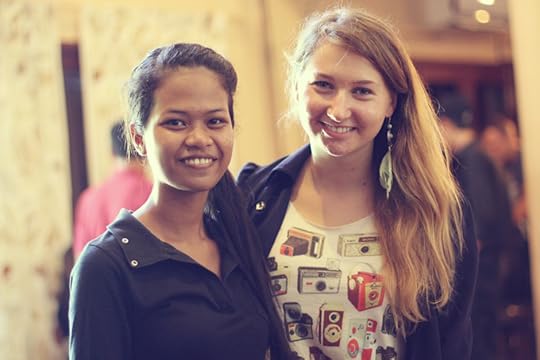
Photo: ND Strupler
1. You sniff your loved ones.
Cambodian culture has different rules for physical touch. It’s not appropriate to kiss your family members or loved ones. Instead, you hug them, and this is often followed by you breathing in the scent of the person you are hugging.
2. You now eat rice three times a day.
In the Khmer language, when you ask someone if they want to eat, you ask “nyum bie?” It literally translates to “Do you want to eat rice?” Like many other Asian cultures, Cambodia’s staple food is white rice. You always start with a steaming bowl of it, to which you add some kind of fresh fish or pork as well as a mixture of green vegetables and some chili peppers in fish sauce. All of these pieces of the meal are kept separate until you actually start to eat.
3. You greet people with the sampeah.
Cambodians greet people and show respect by drawing their hands together at their heart in prayer. You can also show respect to elders by showing this gesture and slightly bowing your head. The highest display of respect is reserved for priests and those of the highest status. You will often see people bend and touch a priest’s feet in order to receive a blessing. You know it’s offensive to forget a greeting and so it becomes habit, even when you leave Cambodia.
4. You call people by a title instead of their name.
Cambodian people are intensely aware of the age difference between you and themselves. One of the first questions you will be asked when meeting someone for the first time is about your birthdate. From that moment on, you’ll be known either as an elder or younger brother or sister. An older brother is called Bong proh, while an older sister is Bong srei. If someone is younger than you, it is acceptable to call them by their first name or add P’ohn in front of proh (boy) or srei (girl).
5. You point at people with your middle finger.
Cambodian people find pointing with your index finger to be very impolite. The middle and pinky fingers are thus your replacements. It’s only appropriate to point at people who are younger than you, though, so you find it best to avoid pointing at anyone in general.
6. You’ll only cook in a group.
Cambodians love to do daily tasks in groups. From going to the market to making the daily meals, you will learn to do things with family and friends by your side. You learn how to work in a crowd and use the different kitchen tools that Cambodia has to offer. This is also a time for you to share and communicate with the people closest to you.
7. Your body no longer craves processed foods, but rather the freshest of ingredients.
Unlike the western side of the world, you can’t find many processed foods in Cambodia. That’s especially true of communities on the water, like Sihanoukville, which have a primary diet of rice, vegetables, fruits, and seafood. A few weeks in Cambodia will make you forget what it’s like to eat anything out of a bag.
8. You expect to hold hands with your close friends as you walk down the street.
Cambodians have a very small personal bubble. If you are friends with a Cambodian, they will sit close to you as you talk and often reach out and touch you mid-conversation. You feel completely comfortable holding hands with any of your friends, regardless of their age or sex. This act of physical touch simply shows that the two of you are intimate friends and that you are as close as family.
9. You smile at everyone you pass and stop to talk to complete strangers.
People in Cambodia are very friendly and open. Many people will stop just to talk and get to know you out of curiosity. This friendliness is contagious in the best of ways. You soon come to realize how much you can learn from strangers who you’d never have met if you hadn’t followed this cultural value.
10. You have the desire to take a two-hour break from work in the middle of the day so that you can go home and nap.
Like in many Asian cultures, a midday break is a vital part of the day in Cambodia. At the hottest part of the day, students come home from school for a break as their parents also have a break from work. You will come to rely on this time to recoup from waking early to finish chores before the heat of the day sets in, as well as to take a much needed shower. Walking through the dusty streets of Phnom Penh in 100% humidity will make showering an important part of your day.
11. You expect to see dancers at every celebration.
Khmer traditional dance is an ancient custom that accompanies any holiday or large gathering. You can easily admire the dancers for their flexibility and movement, moving along to the live sounds of wind and string instruments. Dancers usually wear a traditional top called a sampot which wraps around their bodies. Many times they’ll wear an ornate headdress as well. Much of the dance is done with the hands and feet which are always moving in mesmerizing fashion for the audience. Usually dancing is done only by those who are trained, but on some occasions the audience will take over.
12. You automatically take your shoes off when entering a building.
In Cambodia, you’ll be asked to take your shoes off when entering homes, schools, temples, or anywhere else that holds a place of esteem in the society. It’s a sign of respect.
13. You only eat with a spoon.
No matter what the meal consists of, a spoon is ever-present at the Cambodian table. You get used to scooping up any kind of food with a rather large spoon — be it soup, rice, noodles, or vegetables. Because much of the Cambodian food is on the more liquid side of things, slurping is quite acceptable.
14. You consider everyone in the community to be your family.
The Cambodian mentality is very community based. Holidays are spent with open doors to family and friends in the neighborhood. The Water Festival, celebrated in November, is one of the most joyous Cambodian occasions. You’ll get to know everyone in your community as you spend days drenching each other with water and sharing meals together afterward. If a job needs to be completed, you’ll work together with your neighbors to accomplish it. The Cambodian people come into each other’s houses as if they were all blood related. 

50 things to do before you die
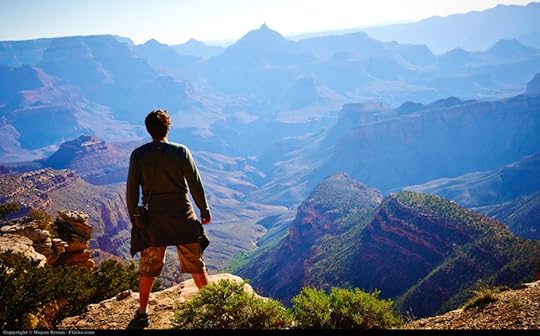
Photo by Moyan Brenn on Flickr
Collected from Matador staff and readers, here are 50 experiences to add to your bucket-list.
1. Set foot on each of the seven continents. Antarctica might seem like a tough one, but here’s how. Once you’ve reached all seven you can truly call yourself a world traveler.
2. Cross a country on a bicycle. A bicycle tour takes some planning, but it beats being separated from a country though a passenger-side window.
3. Ride something bigger than a horse. Trekking through the jungle on the back of a two-story elephant will surely be something you remember forever.
4. Live like a local for a month. The experience of visiting native peoples will give you way more insight into another way of life than two years hopping from one backpacker ghetto to the next.
5. Visit a “real” blues bar in Chicago. What better way to leave music’s commercialism behind and find the soul of the blues?
6. Learn another language. This is definitely a weighty and time-consuming proposition, but there are plenty of resources out there to ease the process.
7. Go heli-skiing. The access to snow and terrain via heli is different (read: better) that anything else you’ll ever experience.
8. Travel India by train. With its extensive rail network, this mode of transport is the best way to see one of the world’s most colorful and diverse countries.
9. Climb one of the world’s Seven Summits. Climbing mountains is not for the faint-hearted, but many people rank standing atop one as one of the things to do before you die.
10. Dive with a whale shark. Swimming with these gentle giants is among the most powerful wilderness experiences in the world.
11. Participate in a Carnival parade in Brazil. You haven’t had a good night out until you’ve been to the biggest party in a nation of big parties.
12. Dance tango in Argentina.
13. Surf. It’s not about being a ripper but just catching waves.
14. SCUBA the Great Barrier Reef. The largest coral reef in the world is a must for dive enthusiasts. It is the world’s most unique aquatic environment.
15. Publish an article about your travels. Part of traveling is sharing your experiences with others. Plus, getting published might be easier than you think.
16. Volunteer abroad for a month.
17. Follow in the footsteps of your favorite travel book. What better guide than a book that inspired you to travel in the first place?
18. Take a bush plane ride into Africa’s interior. These lightly visited regions are filled with unique cultures and diverse wildlife.
19. Cross a glacier on foot. Traversing these fast-disappearing natural wonders is an adventure that future generations might not be able to experience.
20. Visit the source of one of the world’s great rivers. Great rivers, like the Nile, have humble beginnings.
21. Climb an active volcano.
22. Buy a boat and learn to sail. Before the Brothers Wright, everyone traveled by wind power. It’s still the most sustainable way to travel there is.
23. Follow your food from field to table. Most people in the world still eat what they have picked with their own hands. Why not get back to these basics?
More like this: 100 things to experience before you die
24. Bathe in the Ganges. What better way to experience the spiritual heart of India?
25. Travel around the world. Sure, you could do this without ever setting foot outside of planes and airports, but few people ever truly traverse the entire globe. Round the world tickets are great for budget-minded wanderers.
26. Photograph an endangered species. Aside from an image you can keep for a lifetime, it will remind you, and others, how fragile life can be.
27. Participate in Burning Man. As they say: “Trying to explain Burning Man to someone who has never been is like trying to explain color to a blind person.”
28. Spend 24 hours alone in the jungle.
29. Learn how to make a national dish. What is the one and only thing that everyone has in common? Eating.
30. Teach English in a foreign country. Sure, it’s a way to fund your travels, but also the experience of a lifetime.
31. Attend a music festival in another country.
32. Cross a country using only public transportation. See a country the way most of its people do: from the window of a bus, train, or ferry.
33. Spend the night in a storied/historic hotel. You might not even have to leave town to experience a night of classic atmosphere.
34. Attend the Olympics. Whatever you say about the commercialism of the Olympic Games, they are one of the biggest events on the planet.
35. Meet your favorite (living) travel writer. They’ve inspired you; now thank them for it.
36. Travel to Germany to experience Love Parade or one of the world’s other big festivals.
37. Partake in a Japanese tea ceremony. This timeless tradition is at the heart of Japanese culture.
38. Join a caravan in the Sahara. See how people can thrive in one of the world’s harshest environments.
39. Go to Oktoberfest. The meeting of over 6 million beer afficionados and drinking song singers is one of the biggest parties in Europe, and definitely one of our things to do before you die.
40. Stand at the North or South Pole.
41. Be in the stands when two rival South American club teams play each other in soccer. Soccer (sorry, football) is a passion for most of the world’s population.
42. Visit the birthplace or grave site of a cultural icon. Could be Che Guevara or Picasso or Levi Strauss or the guy who invented widgets; anyone you think is important.
43. Find your version of “The Beach.” One of the best travel books ever inspired a generation of backpackers. Why not find your own version of untouched paradise?
44. Enjoy a freshly rolled cigar in Cuba. Taste a hand rolled specialty close to its source.
45. Visit every capital city in Europe. The crowded continent is full of beautiful architecture and diverse cultures.
46. Watch an orchestral performance in Vienna.
47. Skydive. It is the ultimate thrill, unless you add a wingsuit, and actually fly.
48. Bike the Pacific Coast Highway.
49. Shake hands with someone who has truly changed a country.
50. Participate in the world’s biggest water fight during Thailand’s New Year’s festivities (Songkran). 
What would you add to this list of things to do before you die?
This post was originally published on July 7, 2008.

Matador Network's Blog
- Matador Network's profile
- 6 followers


